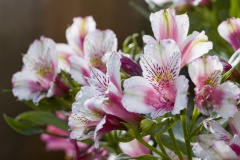Alstroemeria
| Infobox on Alstroemeria | |
|---|---|
| Example of Alstroemeria |  |
| Facts | |
| Origin | - |
| Stowage factor (in m3/t) | - |
| Humidity / moisture | - |
| Ventilation | - |
| Risk factors | - |
Alstroemeria
Contents
Description
Scientific name and introduction
Alstroemeria cvs., hybrids. In the last 20 years, flowers or various hybrids of species of the genus Alstroemeria, variously called Alstroemeria, Peruvian Lily, or Lily of the Incas, have become an increasingly important part of commercial cut flower trade. Flowers come in a variety of types and colours. All have a long post-harvest life, typically terminated by petal wilting and/or drop and yellowing of the leaves.
Quality characteristics and criteria: For long-distance markets, flowers are harvested when the buds are about to open and start to colour. For local market, harvest is delayed until the first three flowers have opened. Flowers are pulled off or cut, depending on the variety. Where pulling may damage the underground parts of the plant, the stem should be cut. If flowers are cut, the remaining stem should be removed later. At least one flower per stem should be open at time of purchase.
Grading and bunching
There are no grade standards for Alstroemeria, but in addition to the common characters of freedom from damage, stem length, strength and straightness, it is suggested that the flowers in a bunch should be uniform. The flower head should be symmetrical, and leaves should be bright green. The minimum acceptable number of florets per stem varies with cultivar, but is typically 7 to 10.
Ethylene sensitivity
Alstroemeria flowers are ethylene sensitive.
Pretreatments: Although untreated Alstroemeria flowers have a long vase-life; petal drop (particularly a problem if there is ethylene in the environment) can be delayed by pre-treatment with 1-MCP1 or STS2. In some cultivars, leaf yellowing occurs before flower senescence. It can be delayed by a pulse treatment with a preservative containing growth regulators.
Storage conditions
Alstroemeria should be stored at 0° to 1°C; present information suggests that Alstroemeria can readily be stored for up to 1 week at 1°C.
Packing: Alstroemeria are normally bunched in groups of 10, sleeved, and packed in horizontal boxes. Flower pedicels are affected by gravity and will bend upwards when temperature control during storage is poor.
Special considerations
When re-cutting, remove the whitish or blanched bottom portion of the stem, if present, for maximum solution uptake and life. Leaf removal will reduce vase-life if enough flowers are not present for solution uptake. Since Alstroemeria is a member of the Amaryllidaceaa, a botanical family from which many pharmaceutical products are derived, it is not surprising that some humans get allergic dermatitis from this species.
1 1-MCP = Methylcyclopropene
2 STS = Silver Thiosulfate
Both products are to suppress ethylene response and extend post-harvest shelf life.











